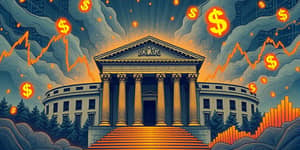
In the ever-evolving world of property investment and home ownership, interest rates serve as a pivotal force shaping both market dynamics and individual decisions. When rates fluctuate, every stakeholder—from first-time buyers to institutional investors—feels the ripple effects across affordability, supply, and long-term valuation.
By diving deep into the interplay between monetary policy and real estate economics, we can equip ourselves with insights to navigate volatility, capitalize on opportunities, and mitigate risks. This comprehensive guide unpacks historical trends, valuation models, and strategic approaches to help you stay ahead in a high-rate environment.
At its core, an interest rate reflects the cost of borrowing money. The Federal Reserve sets benchmark rates to manage inflation, employment, and overall economic growth. When the Fed raises or lowers the target rate, it cascades through the bond market, influencing mortgage and commercial loan yields.
For homeowners and investors alike, understanding this mechanism is vital. A modest policy adjustment can translate into thousands of dollars in additional annual mortgage payments, altering purchasing power and reshaping property demand across regions.
Prior to 2022, mortgage rates lingered near historic lows—averaging around 3.4% in January 2022 for a 30-year fixed loan. By October of the same year, rates surged above 7%, driven by aggressive rate hikes aimed at taming inflation.
This rapid ascent has persisted, with rates holding near 6–7% through mid-2025. The result has been a palpable slowdown in market activity, as higher finance costs squeeze budgets and cool buyer enthusiasm.
Higher interest rates inherently raise borrowing expenses, directly impacting monthly payment calculations. The compounding effect of rising home prices and increased mortgages can create a sustained rise in borrowing costs that many buyers find difficult to absorb.
Simultaneously, a long-term homeowner enjoying a low-rate mortgage is often unwilling to sell, leading to a lock-in effect restricting inventory. This phenomenon further tightens supply, even as overall demand softens.
Real estate professionals frequently rely on a discounted cash flow model or income capitalization approach to value properties. In these models, future rental income and resale potential are discounted back to present value using a capitalization rate, which often tracks the risk-free rate plus a premium.
An uptick in benchmark yields inevitably boosts discount rates, thereby lowering the present value of expected cash flows. Properties with variable-rate financing exhibit pronounced sensitivity to floating-rate debt exposure, making their valuations especially vulnerable during rate spikes.
In a high-rate environment, investors demand higher returns for income-generating assets, pushing cap rates upward and valuations downward. Savvy market participants employ ongoing Federal Reserve policy adjustments as a signal to recalibrate portfolio exposures.
Beyond debt strategies, some investors target distressed assets that emerge when leveraged owners struggle with refinancing. This opportunistic approach requires rigorous due diligence and a clear understanding of local market fundamentals.
As interest rates continue to ebb and flow, staying informed is non-negotiable. Prospective buyers and seasoned professionals must blend macroeconomic awareness with localized intelligence to make sound decisions.
Consider factors such as rental yield potential, time horizon, and financing structure when evaluating new opportunities. Renting may become more attractive if ownership costs surge, altering market composition and regional demand patterns.
Ultimately, mastering the complex relationship between interest rates and real estate is not about predicting every twist and turn. It’s about building resilience through adaptable strategies, continuous learning, and strategic risk management. By doing so, you position yourself to thrive—regardless of whether rates ascend, plateau, or recede.
References













